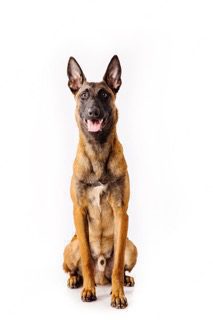
The Belgian Malinois is a intelligent and medium-sized herding breed originally from Belgium. Their origins can be traced back to 1891 when a variety of sheepherding dogs were crossed with each other. They have a strong and muscular body with a proud carriage, pointed ears, and a comparatively short muzzle. Their coat is short, fine, and always fawn-colored with a black mask. They have thicker feathering around the neck, chest, and legs, while their tail often has a black tip. Other color variations include bright yellow, red-fawn, or cream. These dogs were bred with breeds such as German Shepherds, Bulldogs, and Terriers to give them the look that we know and love today. The Belgian Malinois is known for its unparalleled athleticism, intelligence, and trainability. What makes them special is their intelligence, drive, and versatility – whether it is herding sheep, searching for explosives, or protecting a family. They differ from other breeds because of their extreme athleticism and intelligence and their intense drive.
The Belgian Malinois is a loyal and noble breed that makes a great companion animal. They are highly intelligent, alert, and active dogs with an outgoing and friendly temperament. Excellent watchdogs, they are obedient and well-suited for tasks that require problem-solving abilities and agility. They are also eager to please and make great family pets who get along well with children and other pets. Early socialization and obedience training is essential for this breed, to ensure that they reach their full potential. Highly energetic, they need regular exercise and physical activities such as daily walks, runs, and fetch games, to keep them fulfilled and in good physical condition. They are not known to be overly vocal and can be kept indoors, provided they are given lots of exercise each day. Belgian Malinois thrive on exhibiting their talents in suitable activities and forming strong bonds with their owners. If trained and socialized properly from an early age, the Belgian Malinois will be an obedient, well-behaved, and devoted companion.
The Belgian Malinois is an intelligent and energetic dog breed that loves to be part of a family. This breed requires a high-quality, balanced diet and plenty of physical exercise to maintain its health. As a breed, the Belgian Malinois needs around 20% protein from meat sources such as chicken, beef, lamb, or fish, up to 25% fat from sources such as poultry fat, sunflower oil, or flaxseed oil, and carbohydrates from sources such as oats, brown rice, and barley. Fresh vegetables and fruits are also essential to their diet, giving them vitamins and minerals. It’s also important to switch up their diet every few weeks and to avoid foods that are high in fat and sodium. At least an hour of physical exercise each day is needed to maintain the Belgian Malinois’s strength and agility.
Responsible ownership is key when it comes to caring for a Belgian Malinois. Make sure to provide them with a home in which they can be safe and supervised and provide a balanced diet and plenty of exercise. To learn more about their specific dietary requirements, visit Way Canina to find out what foods are okay for them to eat and what others to avoid. Overall, having a Belgian Malinois in the family means committing to giving them proper nutrition and care. By following the recommended feeding guidelines and ensuring they get adequate exercise, you can help ensure that your Belgian Malinois stays healthy and happy.
The Belgian Malinois is a active, intelligent, and energetic breed with a lifespan of 12 to 15 years. They are prone to some common health issues such as hip dysplasia, elbow dysplasia, progressive retinal atrophy, and bloat. To ensure your Belgian Malinois lives a long and healthy life it is important to take them for regular veterinary check-ups and vaccinations in order to prevent any illnesses that may arise. Additionally, proper grooming is essential for their coat, including regular brushing, bathing, and ear cleaning. A balanced diet, portion control, and regular exercise are important to prevent obesity in your Belgian Malinois. Ultimately, genetics, diet, exercise, and healthcare all play an important role in determining their longevity.
Are you already an owner of a Belgian Malinois or thinking about getting one? Owning a Belgian Malinois requires a lot of responsibility. Make sure to carefully consider the pros and cons of owning this unique breed. Visit Way Canina to compare different breeds and find helpful information to help you decide if a Belgian Malinois is the right fit for you. Additionally, you can read our blog posts and articles about dog lifestyle and wellness.”